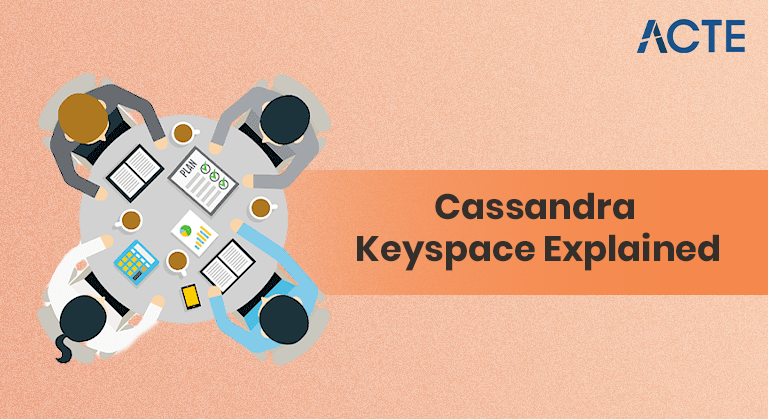
- Introduction to Apache Cassandra
- What is a Cassandra Keyspace?
- Structure and Purpose
- Keyspace vs Database
- Replication Strategy Explained
- SimpleStrategy vs NetworkTopologyStrategy
- Durable Writes Setting
- Creating and Altering Cassandra Keyspace
- Keyspace Best Practices
- Summary
Introduction to Apache Cassandra
Apache Cassandra is a highly scalable, distributed NoSQL database designed to handle large volumes of structured data across many servers with no single point of failure. Built for high availability, fault tolerance, and horizontal scaling, Cassandra is widely used in industries that demand high throughput and low latency. From real-time analytics to decentralized applications, Cassandra provides a robust platform for mission-critical workloads. To master such technologies and drive performance at scale, Big Data Training offers hands-on experience with distributed databases, data pipelines, and analytics frameworks essential for modern data engineering roles. One of the core elements of Cassandra’s data modeling is the keyspace. Similar to a schema or a database in relational databases, the keyspace defines how data is replicated and organized across the nodes in a cluster. Understanding keyspaces is fundamental for designing an efficient and reliable Cassandra database system.
Do You Want to Learn More About Big Data Analytics? Get Info From Our Big Data Course Training Today!
What is a Cassandra Keyspace?
In Cassandra, a keyspace is the outermost container for data. It holds one or more tables, along with settings that define how data is replicated across the cluster. A keyspace is analogous to a schema in traditional relational databases such as MySQL or PostgreSQL. It is the foundation on which tables (or column families) are built and provides control over the cluster’s data distribution policies. Keyspaces help define the scope for data replication and act as a boundary for consistency and availability trade-offs. To choose the right processing engine for distributed data tasks, Spark vs MapReduce compares two powerful frameworks highlighting differences in speed, fault tolerance, and suitability for iterative workloads versus batch operations. Every operation performed within Cassandra, whether it’s creating a table or reading data, takes place inside a keyspace.
Structure and Purpose
The keyspace primarily consists of column families, each containing rows identified by unique keys and grouped by related data attributes. Managing this structure across distributed environments requires coordinated storage and processing capabilities. What Is a Hadoop Cluster explains how clusters of nodes work together to store, process, and manage large-scale datasets efficiently across fault-tolerant systems.

- Name: The identifier for the keyspace.
- Replication Strategy: Defines how and where the data is replicated.
- Durable Writes: A boolean flag that determines whether data is written to disk before acknowledgment.
Example definition:
- CREATE KEYSPACE my_keyspace
- WITH replication = {
- ‘class’: ‘SimpleStrategy’,
- ‘replication_factor’: 3
- } AND durable_writes = true;
In this example, the keyspace is named my_keyspace, uses the SimpleStrategy replication, and enables durable writes.
Would You Like to Know More About Big Data? Sign Up For Our Big Data Analytics Course Training Now!
Keyspace vs Database
While both keyspace and database serve as containers for data, the primary difference lies in the data modeling and replication context. In Cassandra, keyspaces define replication scope and consistency boundaries. For systems like Splunk that ingest high-volume logs, managing duplicate events is critical. Dedup : Splunk Documentation. explains how to filter repeated entries efficiently, improving search accuracy and reducing storage overhead in log-heavy environments.
- A keyspace defines replication and consistency boundaries.
- Tables within a keyspace share the same replication strategy.
In contrast, a traditional database contains schemas and tables but does not inherently control how data is replicated across multiple nodes. This makes keyspaces more tightly coupled with infrastructure-level configurations.
Replication Strategy Explained
When working with Apache Cassandra, choosing the right replication strategy is essential for keeping data available. SimpleStrategy and NetworkTopologyStrategy. SimpleStrategy works best for single data center setups, as it distributes replicas in a clockwise direction around the ring. However, it’s not recommended for production environments that use multiple data centers.

For instance, you might set it up with parameters like class: SimpleStrategy and replication_factor. On the other hand, NetworkTopologyStrategy is tailored for applications that run across multiple data centers. To gain hands-on experience with such configurations and distributed systems, Big Data Training provides practical exposure to data replication strategies, fault-tolerant architectures, and scalable analytics platforms. This strategy lets you specify different replication factors for each data center, making it perfect for enterprise applications that need global coverage. In summary, selecting the right strategy is important for optimizing read and write operations while ensuring that your data stays accessible.
Gain Your Master’s Certification in Big Data Analytics Training by Enrolling in Our Big Data Analytics Master Program Training Course Now!
SimpleStrategy vs NetworkTopologyStrategy
| Feature | SimpleStrategy | NetworkTopologyStrategy |
|---|---|---|
| Use Case | Single Data Center | Multiple Data Centers |
| Flexibility | Limited | High |
| Per-DC Replication | Not supported | Supported |
| Production-Readiness | No | Yes |
SimpleStrategy is easier to configure and understand, while NetworkTopologyStrategy provides better control and fault tolerance in geographically distributed setups.
Durable Writes Setting
Durable writes in Cassandra are vital for data integrity and recovery. When durable_writes is set to true, Cassandra logs each write operation in the commit log before saving it to the memtable. This method ensures that even if a crash occurs, the data can be recovered. This makes it a reliable choice for production environments. On the other hand, setting durable_writes to false can improve performance because it skips the commit log. To orchestrate such trade-offs across distributed systems, What is Data Pipelining explores how structured data flows enable fault tolerance, performance tuning, and reliable recovery mechanisms in modern architectures. However, this option increases the risk of data loss. Therefore, it is generally used for experimental or analytical settings rather than regular operations. For most production systems, keeping durable writes enabled is the best way to protect against data loss and ensure application stability. A typical configuration would include the command: WITH durable_writes = true; to keep this data protection feature intact.
Preparing for Big Data Analytics Job? Have a Look at Our Blog on Big Data Analytics Interview Questions & Answer To Ace Your Interview!
Creating and Altering Cassandra Keyspaces
You can create a keyspace in Cassandra using the CREATE KEYSPACE command and modify it later using ALTER KEYSPACE. To extract and manipulate log data within such distributed systems, What is Splunk Rex explains how regular expressions can be used in Splunk to parse fields, transform events, and enhance search accuracy across large datasets.
- // Create a keyspace:
- CREATE KEYSPACE ecommerce
- WITH replication = {
- ‘class’: ‘NetworkTopologyStrategy’,
- ‘us-east’: 3,
- ‘us-west’: 2
- } AND durable_writes = true;
- // Alter a keyspace:
- ALTER KEYSPACE ecommerce
- WITH replication = {
- ‘class’: ‘SimpleStrategy’,
- ‘replication_factor’: 2
- };
Altering replication settings allows administrators to adjust the resilience of the database in response to changes in demand or infrastructure.
Keyspace Best Practices
- Choose the Right Replication Strategy: Use NetworkTopologyStrategy in production, especially with multiple data centers.
- Avoid Too Many Keyspaces: Overuse of keyspaces can complicate management and slow down repair and compaction tasks.
- Set Durable Writes to True: Ensures data safety during crashes.
- Use Meaningful Names: Helps in organizing and identifying environments (e.g., sales_prod, inventory_test).
- Monitor Performance: Keyspace configuration affects performance; monitor latency, replication, and compaction.
- Consistency Levels: Match keyspace replication with appropriate consistency levels (e.g., QUORUM, ONE, ALL).
- Test Changes: Always test keyspace configuration changes in staging environments before applying to production.
Summary
A keyspace in Apache Cassandra is a central concept that governs how data is stored, replicated, and managed across nodes. It acts as a logical namespace and defines critical properties such as replication strategy and durable writes. The two primary replication strategies SimpleStrategy and NetworkTopologyStrategy determine how data is distributed across single or multiple data centers. Effective keyspace design ensures high availability, fault tolerance, and scalability. To master these distributed architecture principles and apply them in real-world scenarios, Big Data Training equips professionals with hands-on experience in data modeling, replication strategies, and scalable system design. From creating and altering keyspaces using CQL commands to adopting best practices for durability and performance, understanding keyspaces is essential for anyone working with Cassandra. As businesses scale their data infrastructure, properly configured keyspaces provide the foundation for secure, resilient, and efficient data operations. In conclusion, Cassandra’s keyspace architecture offers the flexibility and robustness required for modern, distributed applications. Whether you’re designing a data model for a social media platform, e-commerce website, or real-time analytics engine, leveraging the power of keyspaces can help you build a scalable and fault-tolerant system.


